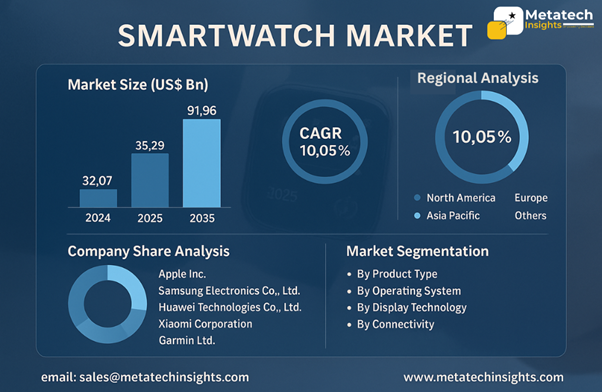Global Smartwatch Market to Hit USD 91.96 Billion by 2035 | CAGR 10.05%
09 Aug 2025 | Report ID: MI3341 | Industry: Novel Technology | Pages: 220 | Forecast Year: 2025-2035

Read more about this report- Global Smartwatch Market to Hit USD 91.96 Billion by 2035 | CAGR 10.05%
The Smartwatch Market is valued at USD 32.07 billion in 2024. The Smartwatch Market will achieve USD 91.96 billion by 2035 through a projected 10.05% CAGR from 2025 to 2035.
In the post-pandemic era people have adopted prevention-focused health management, and smartwatches have primarily been marketed in response to consumers' growing need and desire to track fitness and health. But the costs of the devices are still high, and the batteries have poor battery life, which does not allow mass adoption, particularly in developing economies. Conversely, health insights based on AI and combined with telehealth systems can present new growth opportunities, given that smartwatches become medical-grade wearables.
The market is divided based on product type into extension smartwatches, standalone smartwatches, and hybrid smartwatches. It comprises watchOS, Android Wear, RTOS, and others by operating system. OLED, LCD, and others fall under display technology. Connectivity: It has Bluetooth, Wi-Fi, NFC, LTE, and 5G. They range in such features as health monitoring (heart rate, SpO2), GPS, smart assistants, and calling abilities. This target segmentation includes end users (ordinary consumers, sports and healthcare consumers, or the aged). The leading trend is the health-related and wellness-related smartwatches, which are on the increase based on the number of people becoming aware of their chronic diseases and trusting them to be more fit. The enhanced add-on of ECG and continuous glucose monitoring capabilities has also made such devices more attractive to all populations.
Smartwatches can be found in fitness tracking, health diagnostics, remote patient monitoring, communications, and infotainment. Telehealth monitoring moves fast already with smartwatches that already use biosensors and AI algorithms to detect atrial fibrillation, sleep apnea, and even stress levels, and incoming FDA approvals are already making consumers more confident and clinicians take them seriously. Aspects such as miniaturization of sensors and low-power processors, as well as the flawless integration of smartphones in the market, are factors that keep getting improved. Efforts such as the Fit India Movement and digital health records in Ayushman Bharat have increased the rate of adoption in some sectors, including urban or semi-urban, as well as among the youth and early tech adopters in India.
Geographically, the market is divided into North America, Europe, Asia Pacific, Latin America, and the Middle East & Africa. North America is a first mover because of the great penetration of technologies used by consumers and fast feature innovations by major brands. The fastest-growing is Asia Pacific, which is driven by surging disposable incomes of people, large-scale smartphone penetration, and state-led digital health awareness. The promising growth in China is gaining a lot of traction, evidenced by the entry of tech giants into cost-efficient, high-featured smartwatches with increasing penetration in the countryside.
The dominant market participants in the smartwatch market would be Apple Inc., Samsung Electronics, Huawei Technologies Co., Ltd., Garmin Ltd., and Fitbit (which is a Google LLC brand). Apple is still steaming ahead in the innovation of health functions such as blood oxygen and ECG, whereas Samsung is experimenting with AI-enhanced health tracking, as well as the incorporation of smart ecosystems. Huawei and Garmin are progressing in Asia and Europe, respectively, on long battery life and specific applications towards sport models, and Fitbit is investing in affordability and adapting to Google Health AI compatibilities to gain a customer base.
Maximize your value and knowledge with our 5 Reports-in-1 Bundle - over 40% off!
Our analysts are ready to help you immediately.
